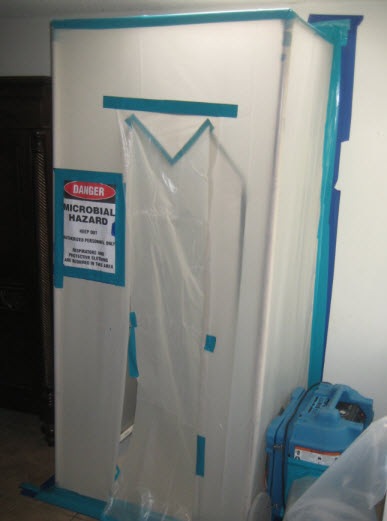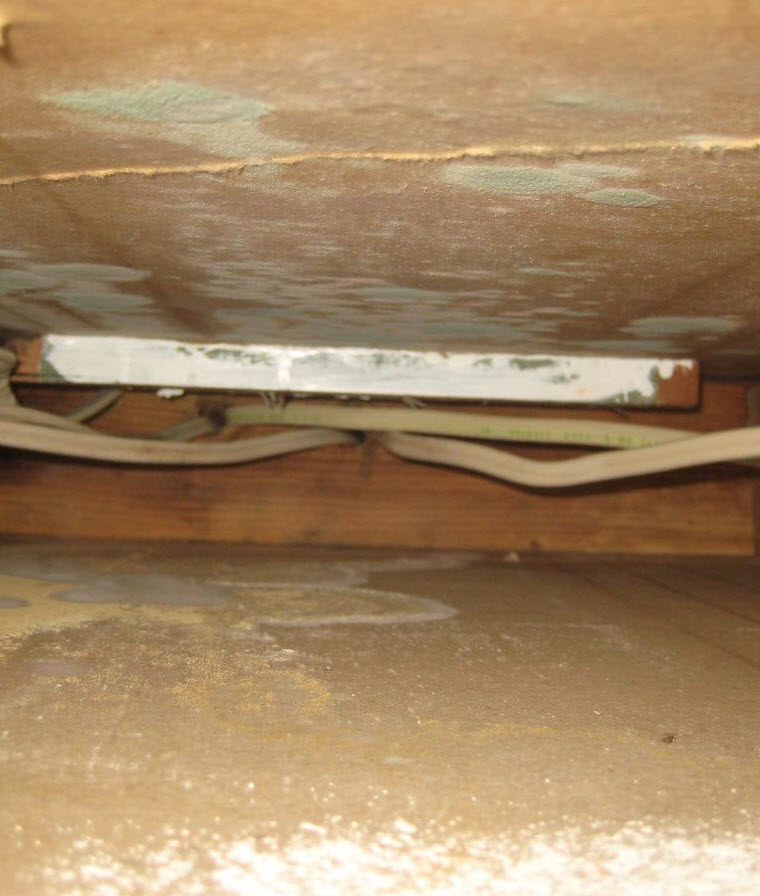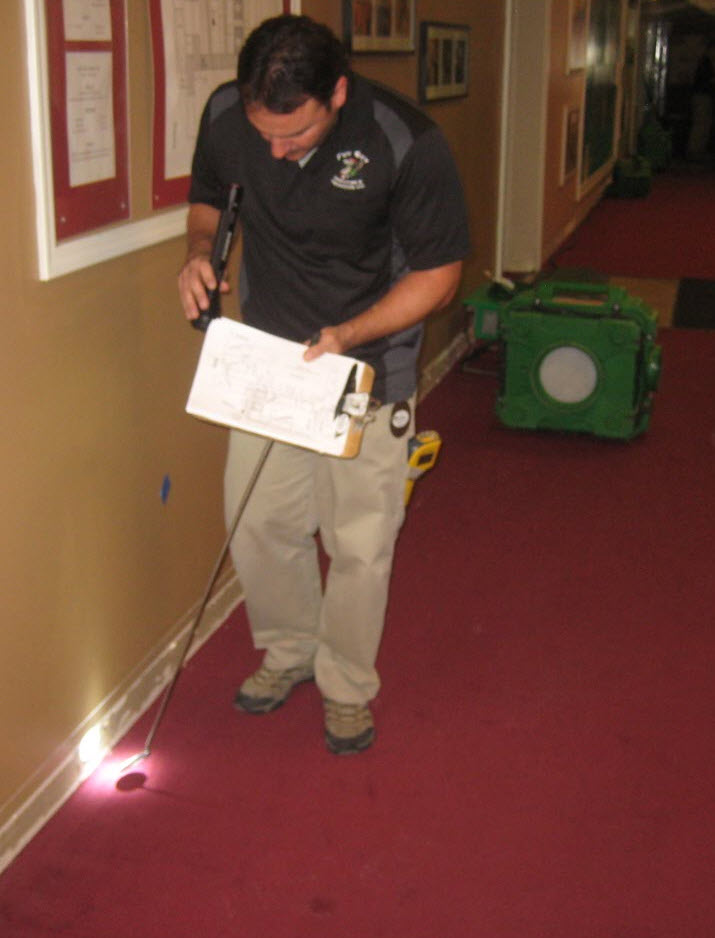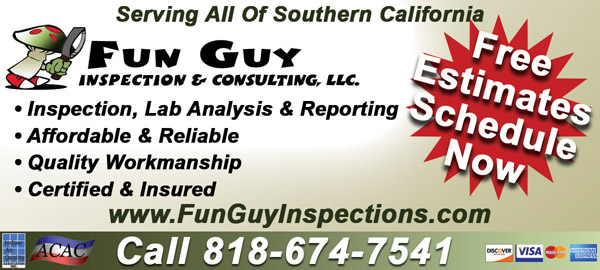Mold Removal | Los Angeles, CA
Learn More about mold removal and cleaning
(866) 674-7541
Certified Mold Removal Company in Los Angeles
Removing mold can be a simple if you use the right tools. The most important step in the mold removal process is using a certified mold removal company. The professionals use a containment barrier, made from plastic, to keep in all the dust and mold spores. In addition, a negative air machine with a HEPA filter is used to clean the air during and after the mold is removed. After, the entire are is cleaned and disinfected with an anit-bacterial/fungal solution. Following the mold removal efforts a post remediation test can help provide you with a clearance letter; showing that the area is clean and free of mold.
3rd Party Testing
Fun Guy provides an Honest and Reliable, 3rd Party Opinion from a Certified Mold Inspector about the current conditions in your building after mold is removed? A Certified Mold Removal Inspections should be scheduled 8-24 hours after mold removal on your is complete.
Post Remediation Verification
Our verification of mold free conditions within your workspace is established from the water damage industry. Condition #1 the absence of visible mold colonies within the wall/ceiling cavities. Condition#2 Normal moisture content within the building materials. Condition #3 Clean air samples indoors compared to the outdoors.

Containment
Before any mold removal project begins a primary containment should be established and define the work space. Containments help prevent the migration of dust and mold spores from the work space. A containment can be established from plastic and secured with tape.

Mold Removal
Drywall, insulation, and other porous materials with visible mold should be removed from the building. After the moldy materials are removed from the building, they are usually double bagged, and then removed from the primary mold remediation work space.

Mold Cleaning
Not all materials are removed from the area during mold remediation. Lumber, tile, concrete, semi-porous, and non-porous materials can be sanded, HEPA vacuumed, and cleaned with an approved anti-fungal/microbial solution. Learn more about mold cleaning now (866) 674-7541.

Mold Clearance Certificate
How To Remove Mold From Households, Best Ways To Remove Mold
Mold has become a significant problem in the environment sectors, such as homes and workplaces. It is a subset of fungi. Molds can grow on cloth, carpets, leather, wood, sheetrock, insulation, and also in human foods when there is a moist in these things.
Mold grows in moisture or wet environment. If there are air-conditioned buildings and also the doors, as well as windows, kept close in summer, then the spore’s level will be a bit low as compared to the extreme levels.
Some molds can produce toxins (some poisons) that can kill their competing mold in their territory. These toxins can be very dangerous for humans when inhaling or in contact with skin. Many building materials provide proper nutrients that encourage mold to grow.
The most common molds which spread indoors are Penicillium, Aspergillus, Alternaria, and Trichoderma. When there is large mold infestation, it can be smelled or seen.
How Can Mold Be Dangerous to Human Health?
People who are very sensitive or they already suffer from the diseases such as allergies, asthma, or they occupy the moldy buildings which are at high risk of their health problems such as metabolites, toxics, or other components. The most common problem that can be caused by mold is an allergic reaction.
Other problems that can be affected by molds are respiratory or immune system responses that include asthma, allergy, and fungal sinusitis. Some of the molds can also produce mycotoxins that can be very high risks of health to humans as well as animals.
Spending your time in damp and moldy houses can increase the risk of bronchitis and also respiratory infections.
Symptoms
Symptoms that caused by molds can include:
- Dry, scaly skin
- Cough
- Sneezing
- Runny nose
- Watery nose
- Itchy eyes, nose, and throat
- Postnasal drip
Mold symptoms vary from person to person from normal to severe. You may have year-round signs or symptoms that flare up only during certain times of the year.
Why Is It Essential to Remove Mold from Your Buildings?
If you are a contractor who finds mold, you must clean up and remove mold as soon as possible. Many people try to remove mold themselves, but sometimes they don’t get it all because of inexperience. That’s the reason you need to hire an expert to do this job. If the mold cannot be remover properly so, you have to remove carpet, drywall, furniture, mattresses, or other items from your houses.
Mold can cause many health problems for those people who are sensitive or allergic to it. It includes skin irritation and respiratory problems.
Some types of mold also can destroy building materials such as furniture etc. That is why it is imperative to remove mold by an expert to save your household equipment from being damaged by mold.
Now we will discuss some of the best techniques to remove mold from your house or workplace.
Types and Techniques to Remove Mold
There are many techniques from which you can remove mold, but here I would like to discuss some of the best methods that can help you to remove mold easily:
Containments
It is the Mold removal technique used to protect the rest of the home from being contaminated by a mold damaged area.
You will need some equipment to rent at a local tool rental shop, while others can be bought at places such as Home Depot.
Some of the significant personal protective equipment you will need to be put on. It includes a minimum (N-95) mask, booties, goggles, rubber boots, rubber gloves, and a Tyvek suit if the mold is nasty.;
There are some steps to remove the mold using a containment barrier:
Step 1: Establish a Work Area
You will have to decide where you will install your containment barrier. You have to leave enough space to work as well as your machines could fit in.
Set up the most apparent path from which you can remove the mold damaged building area.
You do not have to seal all opening between containment areas such as windows, doorways, elevator, etc. But it would help if you sealed all cabinets that have cracks and holes.
Step 2: Hang Your 6 Mil Poly
Before hanging Poly, you should install a negative air machine within the work area. All the work area should be clean and sanitized.
Then you take six mil poly and tape it to good with augmentation. Tape and staple the top of the Poly to the ceiling. There may be a need for heavy-duty tape.
Step 3: Strengthen with Poles and Grip Disks
The poles with grip disks should be applied on the floor ceiling. It provides stability to the containment.
Step 4: Take on a Zipper
The last step is to install zipper tape when you open the zipper once it rips the Poly in a perfect line, so you can quickly enter and exit the containment.
HEPA filtration
If someone in your house has Mold allergies, HEPA filter air purifier is used whenever they are present, especially in that room they used to sleep. Some of the Mold spores can still enter your house because they begin from outdoors, so it is difficult for you to get rid of all of them.
If you are cleaning up a Mold problem, you should run a HEPA filter in that area where the clean-up is going on. A HEPA filter can remove them before the mold can grow more.
If there is some area in your house where mold is self-willed such as a ventilated kitchen and bathroom., a HEPA filter can remove Mold spores from the air and lessen the possibility for mold to grow.
Some HEPA tech add-ons
- Plain HEPA:
An unornamented HEPA filter with no new technology is an exceptional Mold removal gadget. Regular replacing of the filter will reduce any probable problem with mold growing on the HEPA filter itself.
- HEPA filter with Antimicrobial Layer:
HEPA filters have been coated with a chemical that kills microbes, which includes Mold spores. It should have no ruinous effect on the function of the filter. It could make very less chance of mold to grow.
- HEPA with Carbon:
Carbon, or activated charcoal, that act in an utterly different way than HEPA filters. Carbon or activated charcoal dd-on will not affect Mold spores, but it can reduce the musty smell.
- HEPA with ionizer:
Ionizers pass on an electrical charge to the particles which are passing through it. It can make them sick to each other (such as HEPA filter). But they can probably improve the HEPA filter’s performance with deem to Mold spores.
Drywall / Wall Removal
Before you start cleaning the area, locate and repair the source of the moisture. You have to do it because the mold will continue to regrow even after the wall has been cleaned. You should consult professionals if you don’t find mold.
Here are ten steps you should follow to remove mold from walls:
- Open windows to allow ventilation.
- Use a vacuum cleaner equipped with HEPA filter to remove Mold spores on the surface of the wall carefully.
- HEPA filters can trap microscopic particles such as Mold spores. It will stop Mold spores from dispersing into the air.
- Once the wall has been vacuumed, begin applying with detergent to the brush or directly to the surface.
- Begin to scrub the wall in a circular motion. Avoid over saturating the wall because this could provide an additional source of moisture from the wall.
- After the area has been purely scrubbed, use a cloth or a paper towel to dry the area.
- Clean the area by wiping it down with the sanitizer like Lysol. It helps to cure any more spores on the surface of the wall.
- Dry the area again with a paper towel or cloth. At this point, it’s reasonable to see some stains remaining on the wall’s surface. You don’t need to be worry; this does not mean that there is still a Mold present on the wall.
- Place the fan next to the wall to allow the area to dry for 24 hours.
- After 24 hours, inspect the area and repeat the process if necessary.
- After the wall has been arid, some stains can be visible. At the point, the wall can be repainted. The mold will not grow as long as the moisture problem has been addressed.
Insulation Removal
There are many purposes that you need an experienced insulation company. If you are preparing to remodel your home, insulation removal is a fantastic job, and you need professionals to handle it.
Attic insulation, crawlspace insulation or wall insulation are the types of Insulation removal.
You will need some things to do insulation removal, which are as follows:
- Cold Water
- Fans
- 1 cup bleach
- Respiratory mask
- Latex/rubber gloves
- non-ammonia detergent
- 1-gallon water
- Wire scrub brush
Get Rid of Mold on Porous Insulation
- Step 1
Open your household doors and windows to ventilate the area. To circulate the air and dry moisture surfaces, you can use fans. You should not use fans if the mold is visible in black or green stains.
- Step 2
Protect yourself when you are working with mold by wearing safety equipment as safety is the most important thing because mold can be toxic sometimes. Avoid direct touch and wear protective gear all the time while working.
- Step 3
Brush all the porous insulation, such as fabric or foam, with a wire brush that is used to remove loose mold. To keep doing the work with speed, make sure to do this because the mold can sometimes be stuck and stop the work. Do this regularly.
- Step 4
Remove insulation and soak it in cold water. Do this to remove mold on porous surfaces.
- Step 5
Scrub the spoiled surface.
- Step 6
Dry the area entirely.
- Step 7
You have to wash fabric or foam with detergent and bleach solution.
- Step 8
Indirect sunlight let the insulation dry.
- Step 9
To protect insulation against Mold growth, spray fungicide spray.
- Step 10
Again place the insulation back to its place after you are done with the cleaning.
Get Rid of Mold on Non-Porous Insulation
- Step 1
Open windows and doors to ventilate the area. It is important because you need to dry the air inside the closed place so that you can bring down the moisture to at least less than 50%.
- Step 2
Protect yourself while working. Wear protective suits all the time for protection against any allergic reactions or infections because mold can affect your health too.
- Step 3
Remove the insulation.
- Step 4
Scarpe the non-porous insulation such as fiberglass
- Step 5
Scrub the contaminated area with a wire scrub brush.
- Step 6
Dry the area thoroughly. Make sure you use air filters for this purpose only because they are faster and easier to use.
- Step 7
Soak insulation in a bleach solution (bleach + hot water)
- Step 8
Dry entirely
- Step 9
Re-install the insulation
Structural cleaning of the lumber with approved HEPA cleaners
For mold and mildew, lumber or wood is an ideal environment because it soaks up water and retains it for long. To remove mold from lumber acting fast is the way to go. It is to minimize the time for work and to minimize the damage to the health of the occupants of the household or people who live and spend time close to this. You’ll need professional help to remove mold if it is not spread on the wood on an area that is not more than 10 square feet.
Step 1:
Take safety measures to keep yourself safe from the exposure to mold spores or toxins. Wear masks, and rubber gloves do not touch the mold barehanded and do not breath without the safety mask. Make sure you don’t let the spores get to your lungs. If you are using bleach to clean, wear protective outwear.
Step 2:
Now, you can use a machine with HEPA filter, vacuum to remove the loosen mold spores from the wood, and along with that, you can also remove the dirt and harmful particles from the wood. Take the vacuum bag and empty it in a plastic bag and dispose of it in a safe manner without getting it.
Step 3:
If lumber or wood is coated with paint or stained, it means that mold has not yet penetrated through the lumber. And this way, you can simply use a simple mixture of warm water and detergent for dishwashing. Use the brush and dip it in the mixture, then rub it over the mold affected area.
If you still see mold on the wood or lumber, use another effective mold killer, vinegar. Fill a bottle with vinegar and spray it on the lumber. Leave it like that for an hour and then come back to see the magic. Now clean or wipe the lumber with a clean towel.
After wiping it with the towel, inspect the wood for any mold that still remains, now if the lumber is completely clean, wipe the lumber, use a rug for this purpose.
Step 4:
However, it does not matter if what kind of lumber it is, if the mold has penetrated through it, you’ll need a solution of something that is strong enough to kill the spores that are under the surface of the material. Create a mixture that includes, 1x of detergent, 10x of bleach, and 20x of warm water. Now you have to apply the solution to the affected area by the mold with a scrub sponge. Leave the mixture applied on the lumber for air-dry.
Step 5:
If you still see mold on the wood, this is the time to try sandpaper. Sandpaper is the only thing at this point that can reach the mold deep inside the lumber. Work on the lumber for some time and then refinish the lumber, it is not just for looks and show of but also for the safety from any future outbreak of the mold. Finally, it is time to get rid of everything that came in contact with the mold affected area. Now make sure you find ways to limit the moisture in the area to stop from this mold spread from happening again.
How Can Fun Guy Mold Inspectors Help You?
Fun Guy Mold Inspections follow a very expert approach. We make sure to provide quality and value by removing the mold for you. We make sure to remove mold from each and every corner and closed place so that no future mold-related problems occur. We inspect by using a third-party expert. They can point out any areas left and clear the site after the work is completed for and construction and other uses.
FUN GUY offers the mold removal service, and you can reach out to us any time to for an appointment, our team member will visit the site for the report, and then we will proceed to the next phase.
In this phase, we remove all the mold from all the places accessible or not, and you can contact us on by clicking here.
Mold Removal vs. Mold Remediation
Significant mold growth may require professional mold remediation to remove the affected building materials and eradicate the source of excess moisture. In extreme cases of mold growth in buildings, it may be more cost-effective to condemn the building than to reduce mold to safe levels. The goals of remediation are to remove (or clean) contaminated materials, preventing fungi (and fungi-contaminated dust) from entering an occupied (or non-contaminated) area while protecting workers performing the abatement.[13]
Cleanup and removal methods
The purpose of cleanup is to eliminate mold and remove contaminated materials. Killing mold with a biocide is insufficient, since chemicals and proteins causing reactions in humans remain in dead mold.


